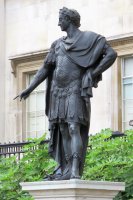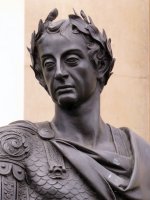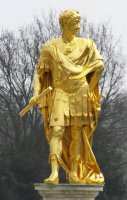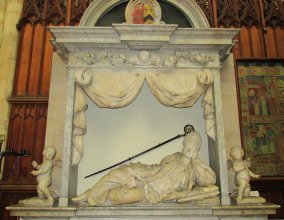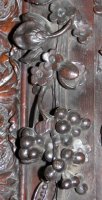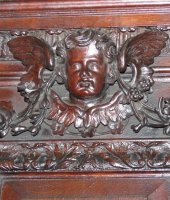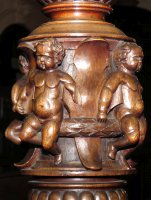Grinling Gibbons (1648-1721)
While Grinling Gibbons is most famous as a wood-carver, and it was in that material which he most excelled, he was also a sculptor, and made some number of portrait statues and church monuments, and other carved works in stone.
Grinling Gibbons was born in Rotterdam, Holland, to English parents, and came to England aged about 19, according to the historian Vertue, thus in the late 1660s, by which time he had learnt the art of carving in limewood, perhaps from the Quellins of Amsterdam. He worked first in York, and then down south to the Thames at Deptford, then in Kent (now part of London), where the famous diarist John Evelyn met him, and was impressed enough by his carving that he recommended the young man for employment to Christopher Wren. Gibbons' woodwork for Wren, including for Windsor Castle and for Wren's St Paul's Cathedral and his City Churches, has given him a reputation that means that ever since, almost any bit of well-carved wood from his times is optimistically ascribed to his hand.
James II, by Grinling Gibbons.
We are interested here in his work in stone. Much has been written, and much effort put into pinning down as many works as possible from his workshop, so I shall keep it brief. Firstly, it is important to recognise that Gibbons became hugely successful in his own times, so that at one time he employed as many as 50 craftsmen in his workshop. This means that much of what he was paid for - which is often the way works are ascribed to his hand - was actually done in part, or entire, by his assistants, who included, at one time or another, several who achieved some eminence in their own right: two Dutch ones in his entourage were John van Nost, and Arnold Quellin (the latter a grandson of the Amsterdam founder of the sculptural dynasty, with whom he later went into partnership with on several of his statues); the English sculptor Francis Bird also worked for Gibbons for a time.
Charles II.
Much of Gibbons' sculptural work does not survive, most notably several statues he made for the Royal Exchange, lost in a fire. However, in central London, we have two conveniently accessible outdoor statues by Gibbons, alone or with his workshop: James II on the north side of Trafalgar Square, and Charles II in the grounds of Chelsea Hospital. They are rather similar in many ways, as both have the king in Roman legionary costume, with chainmail, kilt, bare legs above open-toed boots, and wearing a great cloak swept back behind and down to the ground to provide some extra structural support. The character of both is Roman too, with an emphasis on hard muscularity, and no attempt at flattery to the lined faces. Of the two, the James II statue is much the easier one to appreciate, as the Chelsea statue is gilded.
Archbishop Sterne, York Minster.
There are a variety of monuments by Gibbons, or his workshop, typically grand Baroque things with full-scale figures. Westminster Abbey has several pieces by him, and York Minister has a standing statue of Archbishop Lamplugh, d.1691, and, perhaps more likely by an assistant, a splendid reclining figure of Archbishop Richard Sterne, d.1688, thus rather earlier than his principal monuments in Westminster Abbey, which date from the 1700s. Back in London, on a smaller but still large scale, we can mention two works of 1695: to Dorothy, Lady Clarke, in Fulham Church, with a great funereal urn with knotted drapes, and to Sarah Newdigate, d.1695, in Harefield Church, West London, a massive piece, more cut rather than carved marble but with a pot and two fat cherubs. Much of his other surviving work is for the Royal palaces and a few great houses of the nobility.
A few sample details of Grinling Gibbons' woodwork.
